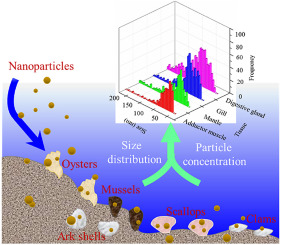Environmental Pollution ( IF 8.9 ) Pub Date : 2020-01-23 , DOI: 10.1016/j.envpol.2020.114043 Lina Xu 1 , Zhenyu Wang 2 , Jian Zhao 3 , Meiqi Lin 4 , Baoshan Xing 5

|
The exposure risk of metal-based nanoparticles (NPs) to marine organisms and related food safety have attracted increasing attention, but the actual concentrations of these NPs in seawater and marine organisms are unknown. In this work, single particle inductively coupled plasma-mass spectrometry (spICP-MS) was used to quantify the concentrations and size distributions of NPs in different marine mollusks (oysters, mussels, scallops, clams, and ark shells) from an offshore aquaculture farm. Results showed that Ti, Cu, Zn, and Ag bearing NPs were detected in all the five mollusks with the mean sizes at 65.4–70.9, 72.2–89.6, 97.8–108.3, and 42.9–51.0 nm, respectively. The particle concentrations of Ti, Cu, Zn, and Ag bearing NPs in all mollusks (0.88–3.26 × 107 particles/g fresh weight) were much higher than that in the seawater (0.46–0.79 × 107 particles/mL), suggesting bio-accumulation of NPs. For all the five mollusks, Ag bearing NPs had the highest number-based bioconcentration factors (NBCFs) in all the tested NPs due to the smallest mean size of Ag bearing NPs in seawater (30.5 nm). In addition, the clams exhibited the lowest NBCFs of the four NPs than other mollusks. All four NPs were mainly accumulated in the gill and digestive gland, and could transfer to adductor muscle of all mollusks. Although all the four metals (Ti, Cu, Zn, Ag) in mollusks were safe for human consumption by the estimated daily intake (EDI) analysis, the risk of NPs remaining in the mollusks should be further considered when evaluating the toxicity of metals for human health. The findings could improve our understanding on the distribution and health risk of NPs in marine mollusks under offshore aquaculture.
中文翻译:

通过单颗粒ICP-MS检测,海洋水产养殖双壳贝类软体动物中金属基纳米颗粒的积累。
金属基纳米颗粒(NPs)对海洋生物的暴露风险以及相关的食品安全性已引起越来越多的关注,但是这些NPs在海水和海洋生物中的实际浓度尚不清楚。在这项工作中,使用单粒子电感耦合等离子体质谱法(spICP-MS)来量化来自海上水产养殖场的不同海洋软体动物(牡蛎,贻贝,扇贝,蛤和方舟壳)中NP的浓度和大小分布。结果表明,在所有五个软体动物中都检测到了含Ti,Cu,Zn和Ag的NP,平均大小分别为65.4–70.9、72.2–89.6、97.8–108.3和42.9–51.0 nm。所有软体动物中含Ti,Cu,Zn和Ag的NP的颗粒浓度(0.88–3.26×10 7颗粒/克鲜重)远远高于海水中的含量(0.46-0.79×10 7颗粒/ mL),表明NP的生物积累。对于所有五个软体动物,由于海水中含银NP的平均尺寸最小(30.5 nm),因此含银NP在所有测试的NP中都具有最高的基于数量的生物富集因子(NBCF)。此外,与其他软体动物相比,蛤exhibit在四个NP中的NBCF最低。这四个NP均主要在the和消化腺中积累,并可以转移到所有软体动物的内收肌。尽管通过估算的每日摄入量(EDI)分析,软体动物中的所有四种金属(Ti,Cu,Zn,Ag)对于人类食用都是安全的,但是在评估金属对动物的毒性时,应进一步考虑软体动物中残留的NPs的风险。人类健康。这些发现可以增进我们对近海水产养殖下海洋软体动物中NPs分布和健康风险的了解。


























 京公网安备 11010802027423号
京公网安备 11010802027423号